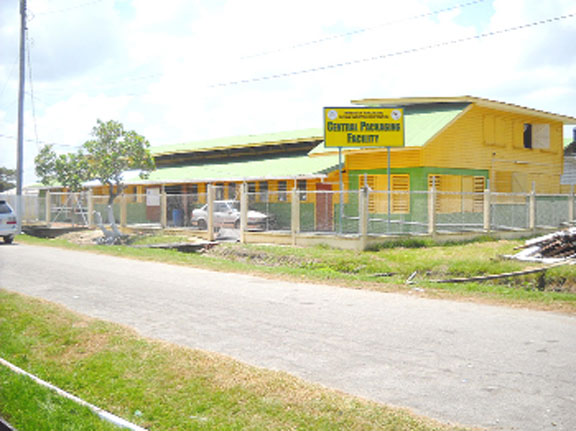– despite focus on stepped up farming, exports
(This is the eighth part in a series on the Grow More Food campaign)
Many days the Parika Pack House is silent with little activity inside the vast building. At times though, particularly in the latter part of the week, trucks roll in and persons clean and pack agricultural produce for export.
However, according to farmers and residents, the $89 million agro-packaging and export facility is underutilized with very few exporters using the building. A number of farmers from the Parika, Ruby and Naamryck area who spoke with this newspaper over the past weeks say that they do not use the facility, which was meant to facilitate their entry into the export business and was talked up by Agriculture Minister, Robert Persaud as opening “tremendous opportunities” to them.
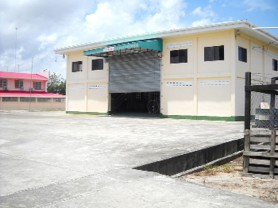
Parika residents, who reside close to the facility, told Stabroek News that it is only periodically that they see the pack house being used. As an example, in the last two weeks of September, although the facility was opened, it was not used. This newspaper learnt that the facility, since it was opened in 2008, has serviced very few exporters.
The Ministry of Agriculture has said that exports have risen but it is not the ordinary farmers who actually get into the business of exporting. A source at the New Guyana Marketing Corporation (GMC) told this newspaper that the pack house is open to exporters only and an export permit from the agency is required before the pack house can be accessed.
On a recent visit to the facility, this newspaper observed that there was no activity done for the day and residents who lived close to the facility said that it was this way most times. The person in charge of the facility, Milton Dookie, was not present when Stabroek News visited. The coordinator at the Central Packaging facility at Sophia said that the Head of the GMC Nizam Hassan would have to give permission for them to speak to the media.
October makes it two years since the Parika facility was commissioned. At its commissioning, Persaud said that the facility opens tremendous opportunities.
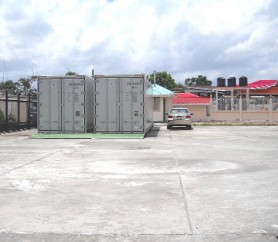
The facility is deeply embedded in the ministry’s ‘Grow More Food’ campaign and it was said that it can prepare and package an estimated 40 000 pounds of produce for export in a 24-hour period. However it is not being used often.
Persaud has said that all produce would be processed at the facility free of cost to farmers and exporters. However, for every pound of produce processed, he had explained, the ministry will incur a $4 processing cost. He had said that the fact that the ministry will not pass on the processing cost to farmers and exporters reflects its seriousness in investing so that farmers would be given the space, incentive and support they need. He further encouraged all farmers to “take full advantage” of the facility.
But Stabroek News learnt that currently only four exporters utilize the facility on a periodic basis.
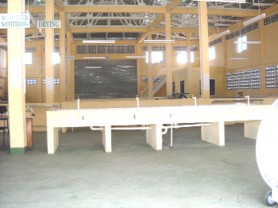
Sometimes the same exporters utilize the Central Packaging Centre at Sophia. It was explained to this newspaper too that problems with shipping contribute to how often the pack houses are used and, for example, as happened recently, a ship that normally took produce directly to Barbados, decided to go to Trinidad before heading to Barbados, and because of the stop-over, the produce would likely spoil, so no produce was shipped out.
The Parika facility is the second of its kind with the first one at Sophia opened in 2001. Work on the infrastructure of the Parika facility commenced in December 2006 and the structure was completed in April, 2008. The ministry has said that for 2009, 2,031 tonnes of fresh produce was prepared for export at the Parika and Sophia packaging facilities.
When this newspaper contacted Head of the New GMC, Hassan for information on the operations of the pack houses he asked that the questions be supplied in writing and he would respond in writing since he prefers to have “a record”. The questions were supplied and a week later, despite reminders and despite his promises, Hassan failed to respond.
Meantime, this newspaper was told that the Sophia pack house is utilized more than the Parika pack house but it too services only a limited number of exporters and this number has not grown by much.
Recently, under the “Improving the Cold Chain for Non-Traditional Agricultural Produce” project, which is financed through a programme of support by the Venezuelan Government to the tune of US$859,600, the New GMC acquired cold storage facilities for farmers in a $66.28 million contract. Four refrigerated trucks and five refrigerated containers were acquired.
Hassan had explained that the trucks will be used to go into the farms where the produce will be picked up and taken to the pack house. Initially farmers supplying exporters will be targeted. If the produce is not going to be exported immediately, it will be stored in the containers. A fee is charged but is heavily subsidized, it had been explained.
Other activities of the project included the purchase of field crates for use by farmers to minimize post-harvest losses from the field to the pack house; the construction of a produce collection area for farmers produce; and the building of a fresh produce pack-house at the Cheddi Jagan International Airport, Timehri which will be used by producers to prepare produce for export.
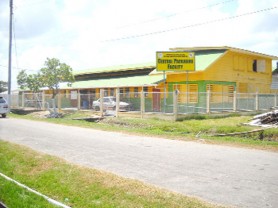
In early 2007, a Government Information Agency release had said that government would be building two packaging facilities at Charity and in Berbice to cater for the export of fruits and vegetables under its agricultural diversification project. GINA had said that all of the facilities will cater for the processing and packaging of fresh fruits and vegetables for export and are intended to promote the non-traditional crop sector as a means of creating employment, increasing income and foreign exchange.

